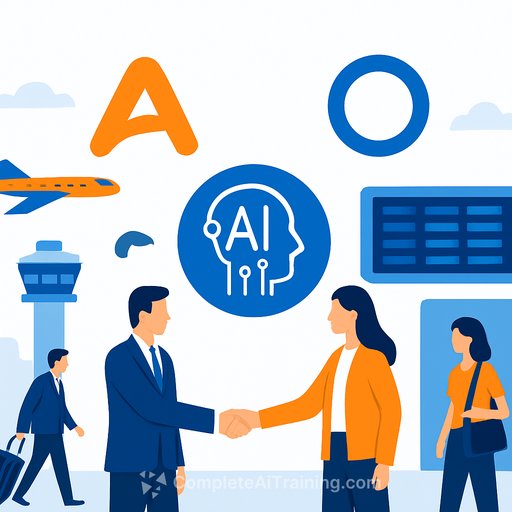Adani Airports and AIONOS join hands to modernise airport operations through AI integration
Last updated: 2 Nov, 2025
Adani Airport Holdings Limited (AAHL) has partnered with AIONOS, a company under InterGlobe Enterprises, to bring AI and data-driven systems deeper into day-to-day airport operations across its network in India. The goal is simple: better throughput, cleaner coordination, and smoother passenger journeys.
This move builds on AAHL's in-house platforms-Aviio, Adani OneApp, and Airport-in-a-Box-so improvements can roll out consistently across multiple airports. For operations teams, that means more accurate forecasts, faster decisions, and fewer manual handoffs.
What this partnership means for operations
- Integrated platforms that connect airlines, ground handlers, security, and regulators for consistent, real-time decisions.
- Automation of routine services: queue forecasting, multilingual virtual assistants, proactive alerts, and SLA tracking.
- Predictive decision support for stand and gate allocation, staff rostering, baggage flows, and turnaround risk.
- Stronger customer interaction via Adani OneApp-parking, lounge access, duty-free, and timely notifications.
The digital stack in play
- Aviio: Links operational data across airlines, ground staff, and regulators to reduce blind spots.
- Adani OneApp: Passenger-facing services that reduce friction and deflect support load.
- Airport-in-a-Box: A template-driven approach to scale capabilities as new airports come online.
- AIONOS AI layer: Forecasting models, anomaly detection, natural language assistants, and workflow automation.
What leaders are saying
Arun Bansal, CEO of AAHL: "We want air travel to feel smoother, faster, and more responsive to passengers. Combining AIONOS's expertise with our tools-Aviio, Adani OneApp, and Airport-in-a-Box-helps us build a connected ecosystem that encourages inclusivity, efficiency, and future-ready infrastructure."
C.P. Gurnani, Co-founder and Vice-Chairman of AIONOS: "Our AI-driven systems will help automate routine services, predict passenger needs, and enable airports to function more seamlessly."
Use cases you can act on now
- Queue and flow prediction: Forecast wait times at check-in, security, and immigration; adjust lanes and staff in real time.
- Turnaround protection: Flag at-risk flights using ground-time, resource, and weather signals; trigger recovery playbooks.
- Stand/gate allocation: Assign to reduce towing and taxi time while protecting on-time performance.
- Dynamic rostering: Build shifts from demand curves; cut idle time and overtime.
- Irregular operations (IROPS): Multilingual passenger updates, automated rebooking prompts, and targeted voucher flows.
- Ancillary nudges: Pre-book parking, lounges, and duty-free pickups in-app to reduce on-site congestion.
KPIs to track from day one
- Departure punctuality (D0/D15) and turnaround variance vs. schedule.
- Average and 95th percentile queue times by checkpoint.
- Stand/gate change rate and taxi-out time.
- Contact deflection rate, CSAT/NPS, and multilingual support resolution time.
- Cost per passenger and energy consumption per passenger.
- Baggage mishandling rate and dwell time by belt.
Data, process, and integration notes
- Key data feeds: AODB, FIDS, DCS, BHS, A-SMGCS/ATC messages, CCTV analytics, Wi-Fi/BLE sensors, and IoT meters.
- Standards and governance: Shared data model, event timestamps, audit trails, and role-based access.
- Human-in-the-loop: Keep operational authority with duty managers for safety-critical calls.
- Privacy: Anonymise PII by default, set retention windows, and surface consent controls in OneApp.
If you want a reference for collaborative decision-making frameworks, see IATA's A-CDM guidance here and ACI's digital transformation insights here.
Rollout checklist for ops leads
- Baseline current KPIs; set target deltas and review cadence.
- Map integrations; define data SLAs with airlines, handlers, and vendors.
- Pilot in one terminal; run shadow mode first; A/B queue models before full cutover.
- Update SOPs; train shift leaders and control room teams; publish escalation paths.
- Establish safety and compliance guardrails; log every automated action.
- Plan comms for passengers and staff; measure adoption and iterate monthly.
Why this matters for India's airport network
AAHL operates multiple airports under the public-private partnership model. A shared AI stack means repeatable playbooks, faster onboarding for new sites, and consistent, multilingual passenger support-while keeping operations stable during growth.
Next steps
- Expect early gains in queue management, disruption handling, and passenger communications.
- Deeper integrations with regulators and ATC can follow once data quality and process discipline are in place.
- Start now: inventory your data sources, close timestamp gaps, and align KPIs with the control room's daily rhythm.
If you're upskilling your ops team on AI workflows, see practical course paths by job at Complete AI Training.
Your membership also unlocks:






